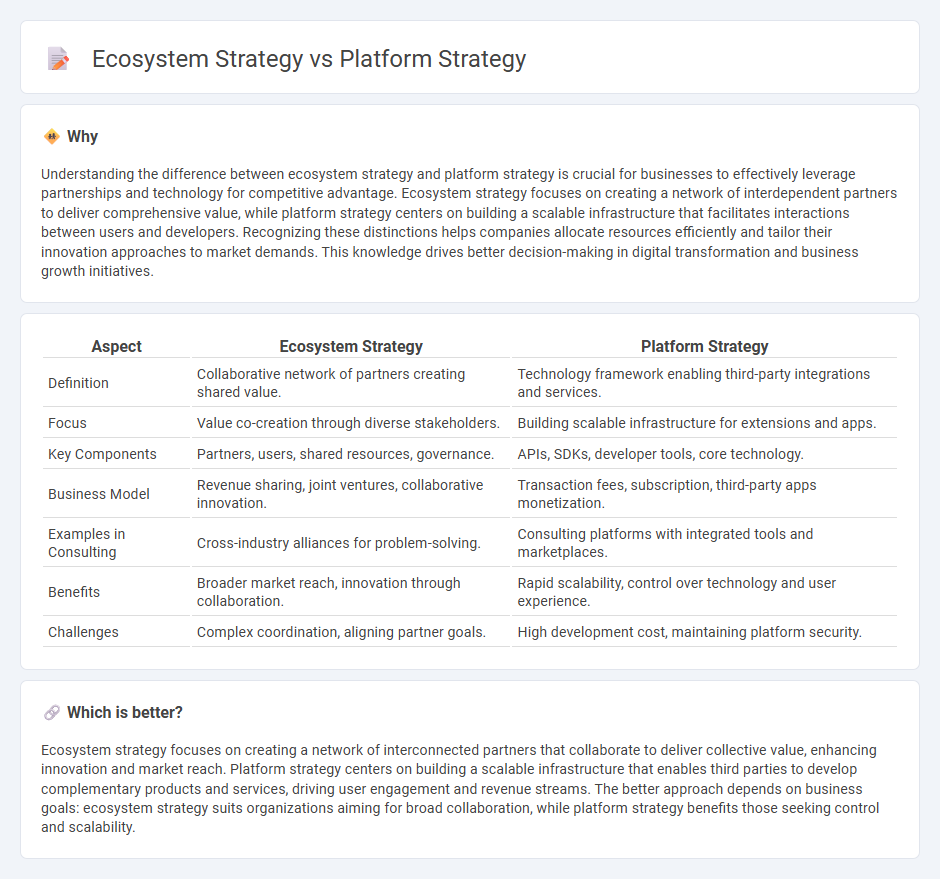
Ecosystem strategy focuses on creating interconnected partnerships and networks that drive collective value and innovation, leveraging external resources and capabilities. Platform strategy centers on building a foundational technology or service that facilitates direct interactions between users, producers, or partners, enabling scalable transaction flows. Discover how businesses can harness these approaches to optimize growth and competitive advantage.
Why it is important
Understanding the difference between ecosystem strategy and platform strategy is crucial for businesses to effectively leverage partnerships and technology for competitive advantage. Ecosystem strategy focuses on creating a network of interdependent partners to deliver comprehensive value, while platform strategy centers on building a scalable infrastructure that facilitates interactions between users and developers. Recognizing these distinctions helps companies allocate resources efficiently and tailor their innovation approaches to market demands. This knowledge drives better decision-making in digital transformation and business growth initiatives.
Comparison Table
| Aspect | Ecosystem Strategy | Platform Strategy |
|---|---|---|
| Definition | Collaborative network of partners creating shared value. | Technology framework enabling third-party integrations and services. |
| Focus | Value co-creation through diverse stakeholders. | Building scalable infrastructure for extensions and apps. |
| Key Components | Partners, users, shared resources, governance. | APIs, SDKs, developer tools, core technology. |
| Business Model | Revenue sharing, joint ventures, collaborative innovation. | Transaction fees, subscription, third-party apps monetization. |
| Examples in Consulting | Cross-industry alliances for problem-solving. | Consulting platforms with integrated tools and marketplaces. |
| Benefits | Broader market reach, innovation through collaboration. | Rapid scalability, control over technology and user experience. |
| Challenges | Complex coordination, aligning partner goals. | High development cost, maintaining platform security. |
Which is better?
Ecosystem strategy focuses on creating a network of interconnected partners that collaborate to deliver collective value, enhancing innovation and market reach. Platform strategy centers on building a scalable infrastructure that enables third parties to develop complementary products and services, driving user engagement and revenue streams. The better approach depends on business goals: ecosystem strategy suits organizations aiming for broad collaboration, while platform strategy benefits those seeking control and scalability.
Connection
Ecosystem strategy and platform strategy are interconnected by focusing on creating value through collaborative networks and technological infrastructure that enable seamless interactions among diverse stakeholders. Ecosystem strategy emphasizes building a symbiotic network of partners, customers, and suppliers, while platform strategy provides the digital foundation and tools for efficient integration and scalability within that network. Together, they drive innovation, market expansion, and competitive advantage by leveraging shared resources and data-driven insights.
Key Terms
Value Proposition
Platform strategy centers on creating value by facilitating direct interactions between users and developers, often leveraging network effects to enhance user engagement and content diversity. Ecosystem strategy expands this concept by integrating multiple complementary products and services from various partners, aiming to deliver a holistic value proposition that addresses broader customer needs. Explore the nuances between these strategies to optimize your business model and maximize value creation.
Network Effects
Platform strategy prioritizes building a robust infrastructure that facilitates direct interactions between users, leveraging network effects to rapidly scale value as more participants join. Ecosystem strategy expands beyond the core platform by integrating partners, developers, and complementary products to create a synergistic environment that enhances overall value and innovation. Explore how these approaches impact competitive advantage and growth by understanding their unique network effect dynamics.
Governance Model
Platform strategy emphasizes a centralized governance model where the platform owner controls access, standards, and value creation mechanisms to maintain quality and coordination. Ecosystem strategy adopts a more decentralized governance approach, enabling diverse stakeholders to co-create value through flexible roles and shared decision-making. Explore the distinctive governance frameworks that shape these approaches for deeper insight.
Source and External Links
What is Platform Strategy and Why Does it Matter? - Ndevr - Platform strategy is an approach to market competition by leveraging a digital platform that connects different user groups, focusing on value creation, scalability, monetization, and ecosystem partnerships exemplified by Google's Android ecosystem.
Platform Strategy - Bain & Company - A platform strategy is a holistic method fostering interactions among diverse user groups to create dynamic ecosystems, beginning with identifying customer needs and leveraging unique capabilities to set the platform apart in competitive markets.
Platform strategy, explained | MIT Sloan - Platform strategy centers on enabling participants to benefit mutually, emphasizing the critical challenge of seeding initial users and making technology the core of a thriving ecosystem, with success relying heavily on strategic user attraction and engagement.
 dowidth.com
dowidth.com